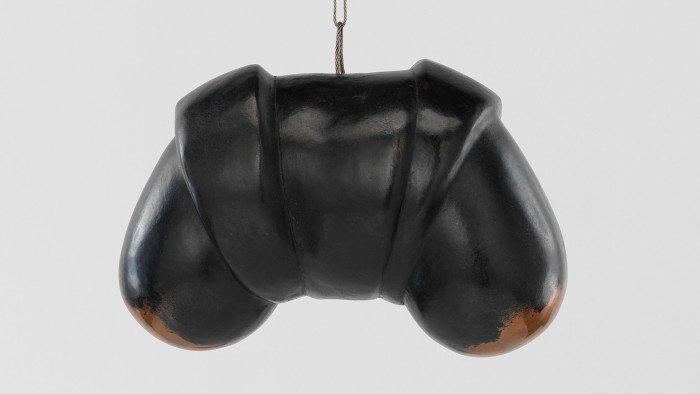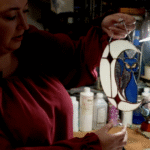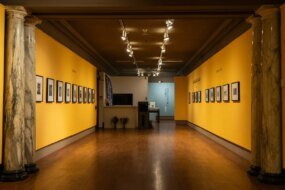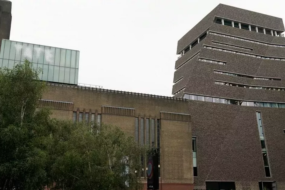
Unlock the Editor’s Digest for free
Roula Khalaf, Editor of the FT, selects her favourite stories in this weekly newsletter.
Visitors to the Courtauld Gallery’s exhibition Abstract Erotic this summer will find themselves staring at a large and erect rubber penis, sheathed in a sickly-yellow skin and strung up from the tip by a wire. This brazen object is the work of Louise Bourgeois, who named it “Fillette”, the French term for “little girl” — just the kind of provocation for which this grande dame of psychosexual modern art is so revered.
Abstract Erotic reunites Bourgeois with the sculptor Eva Hesse and the lesser-known artist Alice Adams (the only surviving member of the trio), for the first time in almost 50 years. Their playful experiments in creating an erotic language highlight just how much the world has changed — and what role art may yet have, in our desensitised age, in reconnecting us to our bodies. In 1966, the three women exhibited together at New York’s Fischbach Gallery in Eccentric Abstraction. Curated by the influential feminist critic Lucy Lippard, that show is now viewed as a turning point in the history of 20th-century art, the moment when bodily forms were reintroduced to the cool and impersonal language of minimalism — the movement du jour of the male-dominated 1960s New York scene.
Elsewhere at the Courtauld, the work is suggestive rather than explicit: the erotic treated as an essential part of how we interact with the material world, not merely as subject matter. We see this in Hesse’s “Addendum”, a row of papier-mâché domes attached to a strip of wood, from which long white cords dangle. Here, the insinuation of a row of breasts leaking milk, or adorned with absurdly long nipple tassels, brings unexpected bawdiness to an otherwise pared-back composition.

Much pleasure has clearly been taken in touch and experimentation. Adams made “Expanded Cylinder” by pressing a chain-link fence into a roll of foam and coating the depressions in latex, creating the effect of scaly skin. Today this work looks dry and crusty — it’s not the only object to suffer from the limited shelf life of what were, at the time, unconventional materials. When Bourgeois made the latex and fabric sculpture “Le Regard” in 1963, the large, lumpen orifice was flesh-like and glistening. Today it is discoloured and desiccated, its degradation an evocative echo of the inevitable withering of the flesh.
What can these relics of a bygone era tell us of art’s relationship with the erotic today? After all, when Hesse, Bourgeois and Adams first shared a billing, it was a time of enormous artistic and sexual experimentation. Carolee Schneemann had recently performed Meat Joy, an orgiastic vision of bodies writhing in raw meat. Yayoi Kusama would soon make clothes with cut-out panels designed to reveal the wearer’s erogenous zones. Rather than the sexual revolution, in 2025 we have social media, incels and a global porn-streaming habit so prodigious that it is responsible for pumping as much carbon dioxide into the atmosphere every year as the entire nation of Nigeria. One of the quirks of living in a culture of extraordinary overexposure is that it has reduced our erotic literacy. Add to this doomy mix the tales of declining birth and sex rates, and it becomes hard to shake the vision of a people overstimulated and undersexed.


Screens have fundamentally rewired our relationship to images and to pleasure and it can be hard for art to compete. It is no longer the transgressive force it once was: tales of daring cultural avant-gardes shaking up prudish societal conventions are now the preserve of historians exploring archives. If Courbet’s once scandalising “L’Origine du Monde” (1866) was made today, it would likely be met with a knowing eye-roll, an image unable to stir those who feel they have seen it all.
Art may have lost some of its ability to shock, but the works in Abstract Erotic show that the sexual nature of an artwork is not limited to whether it depicts explicit images. The erotic is ingrained in the sensory, explorative and experimental process of making, and from the pleasures of looking. Take, for example, Bourgeois’s bronze sculpture “Hanging Janus”, a peculiar, dreamlike object — a cross between a croissant and a double-ended sex toy. At either tip, the patina is worn away to reveal the gleaming metal beneath, like a statue of a saint polished by the worshipful touch of devotees. Bourgeois described her work as “a repeated attempt at seducing somebody”. To view this work is to enter into a flirtation: to follow where the artist leads and to see how far your imagination might travel.

This frisky and open-ended way of engaging with art is markedly different to the direction the cultural sphere has taken in the past decade. Museums and galleries have adopted a model of presenting art that is geared towards moral instruction — exemplified by the trend of presenting women artists as “overlooked” or “rediscovered”; the dominance of art with a social justice mission; and the overwhelming focus on artists’ biographies. As well intentioned as this approach may be, it tends to reduce the meaning to the perceived worthiness of its maker, and shifts our focus away from the naked encounter with the work itself. There is little room, in this equation, for the grey areas in which desire and imagination flourish.
The collection of ageing orifices and protuberances on show at the Courtauld is a reminder that art can still offer us something the digital realm cannot. In the tactility and erotic curiosity of Bourgeois, Hesse and Adams’ work is the chance to reconnect with the body, in all its glorious fallibility and carnality.
To September 14, courtauld.ac.uk







